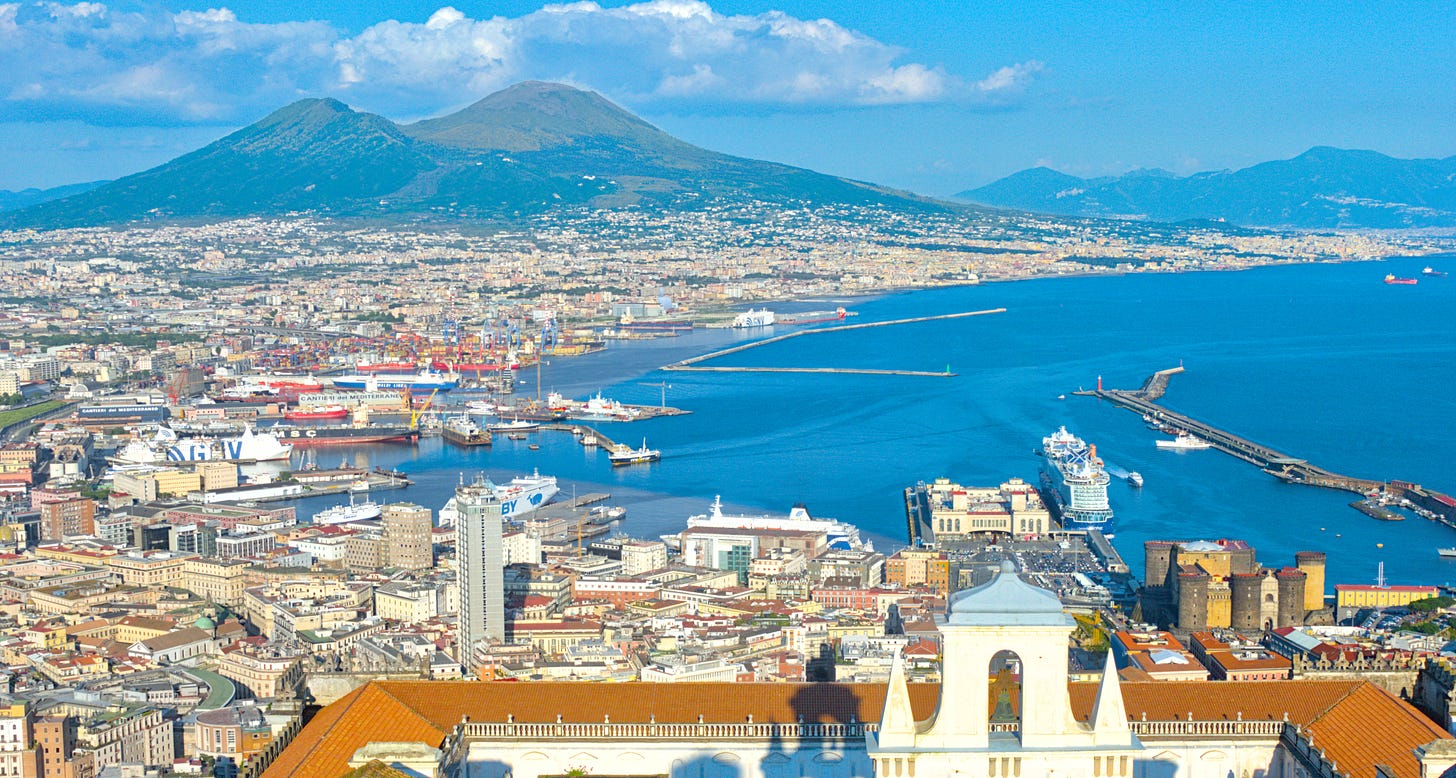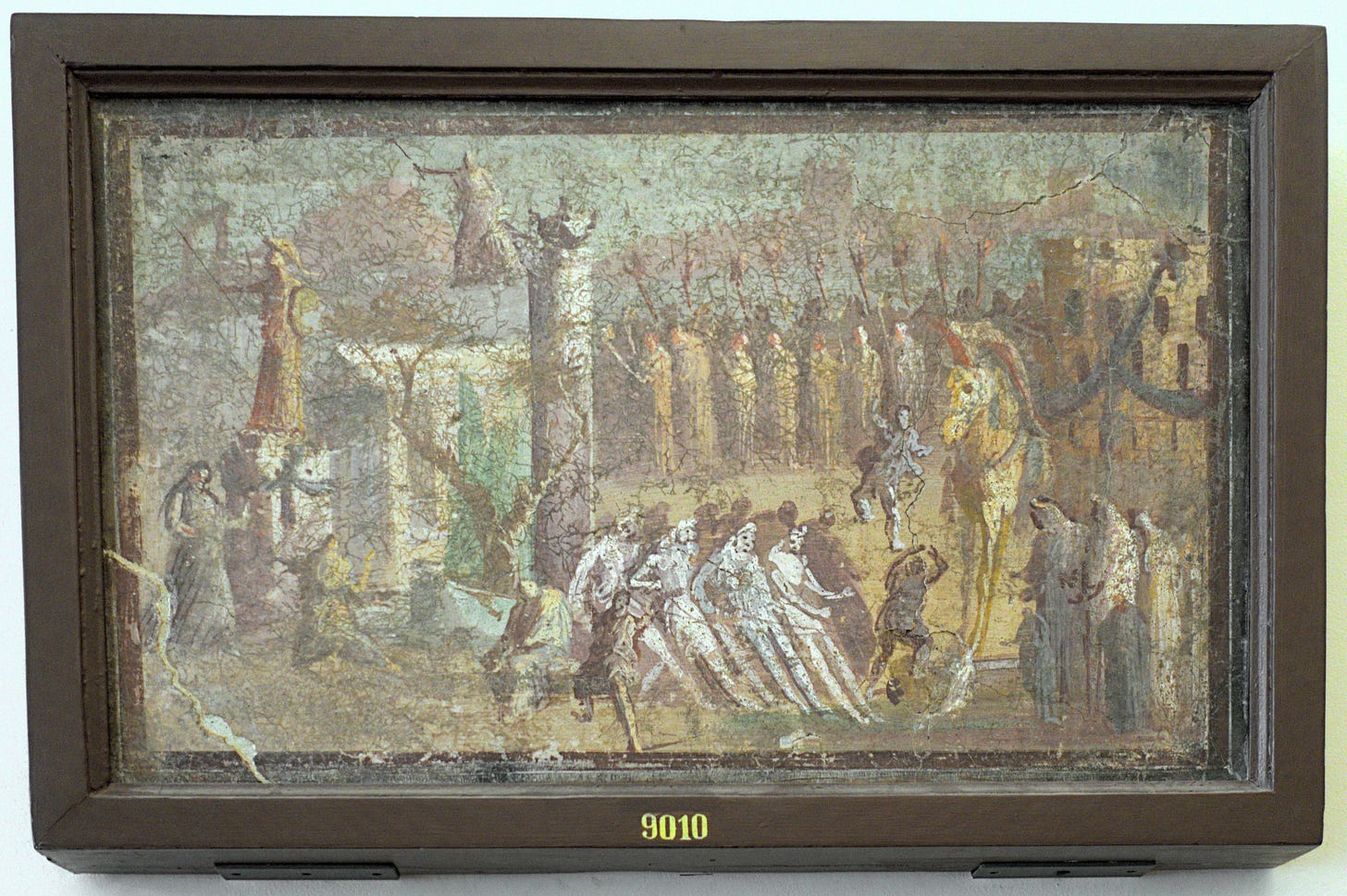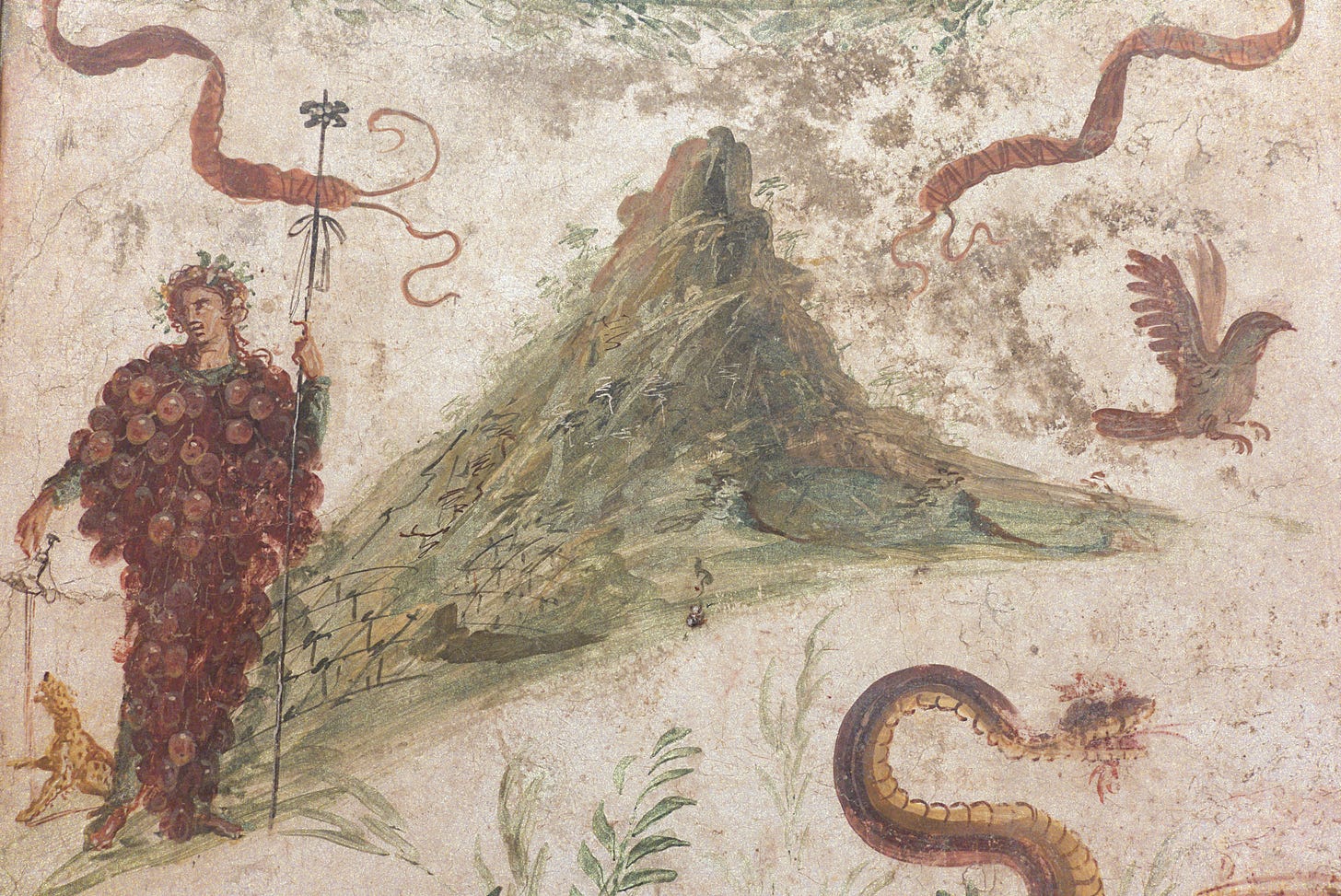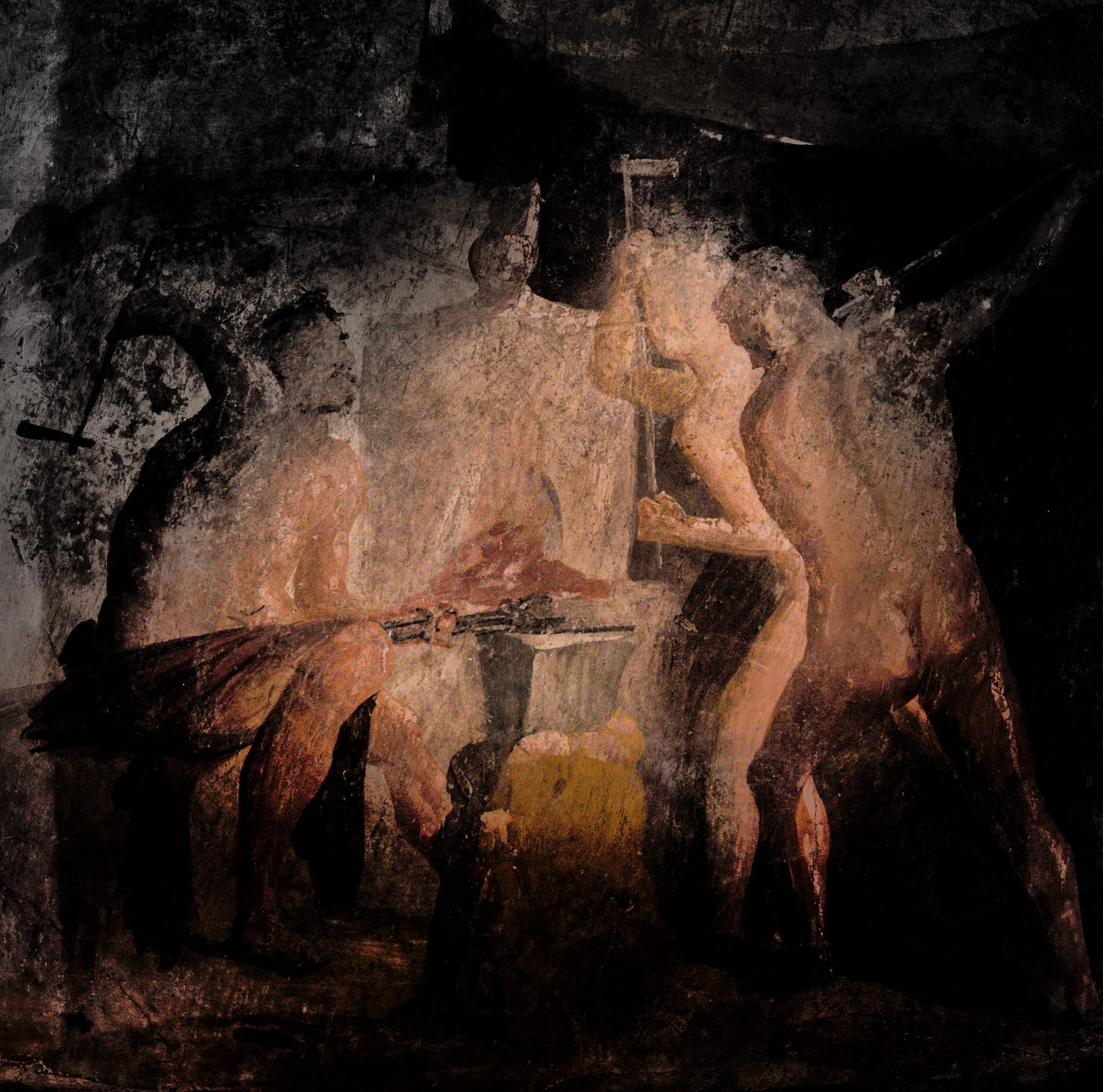Italy has the pleasure and the headache of being home to the most concentrated material remains of history in the world, including many from ancient Greeks. Naturally, I was drawn to these remains and have returned from visiting the eclectic island of Sicily, poking around the museums of Naples, and walking (or diving) ancient streets that Mt. Vesuvius destroyed yet miraculously preserved, leaving in its wake snapshots of ancient life.1
When I say snapshots I mean it quite literally, not only buildings and everyday objects like bread and furniture, but frescoes and mosaics that allow us to enter into the mind and thoughts of the distant past. I have been joking over in Substack Notes that it's almost as if people in the past didn’t create their artwork for themselves. Instead, they consciously curated a representative sample of myth, history, and politics for us, a future alien society.
Let’s imagine the scene…
Say, Virgil, we love that you expanded upon Homer's episode of the Trojan horse, but what if your Aeneid text leaves people in a future millennium wondering if they should imagine the Greeks were actually inside a literal horse-shaped object instead of making a literary allusion? — Yours, Emperor Augustus
Or how about…
Cornelius Tacitus, your Annals (XIV.17) will be a gift to future seekers of history wondering why gladiatorial games were banned following Pompeii's 59AD amphitheatre riots. However, you should know that local gladiator Actius Anicetus prefers a visual spectacle, and as such has commissioned for his house a wall-size painting of the riot to provide less textually-inclined Classics students with material for their art history theses. - Pliny the Younger
And in response...
My dear Pliny, always a pleasure receiving your letters (Epistulae VI.16)! It got me thinking... after that horrible earthquake in 62AD, might Vesuvius blow its top? If it perfectly spreads volcanic ash over Pompeii, then future scholars will be able visit our civilization's smoldering remains. We ought to ensure they have a reference for what Vesuvius looked like pre-eruption. Please get your artist acquaintance on the job, and while they're at it, how about adding someone in a grape costume for the delight of millions of tourists, too? - Tacitus
Of course, my tongue is firmly in my cheek here.
Granted, the ancient people around Vesuvius probably were driven to materially project the achievements and myths of their time for future record (more than our modern societies, at least). But the mosaics and frescoes around the Bay of Naples reflect the tastes and needs of the people at the time, not as visual companions to the ancient texts that have survived for reading today.
Besides, I have written before about the precarious way in which ancient texts survive, and how so few of them have actually made it to our bookshelves today. What are the chances that artwork from a standard Roman working town preserved in a random volcanic event nearly 2,000 years ago would conveniently match the small proportion of ancient texts that have survived elsewhere across the world by different means for that same 2,000 years?
If a wander around the internet tells you anything, apparently the answer is ‘quite high’.
When researching for Culture Cross I’m subject to a constant stream of images depicting ancient Greek philosophers, poets, playwrights, generals, gods, and various myths and historical events. More often than not, these exemplary images of their subjects are a piece of art preserved from the eruption of Mount Vesuvius. This is why I just had to visit the region aroung the still-active Vesuvius, such as Pompeii, Herculaneum, and the Archaeological Museum in Naples which houses the best preserved of the ancient excavated artworks.
It’s hard to explain what it was like to walk the corridors and rooms of Naples Museum’s Vesuvian collections and see (in particular) the ancient frescoes and mosaics. They’re so colourful, full of vigour, and so… expected? It’s as if the paintings are actually conscious beings like the toys in Toy Story, and before I walked into each room they looked at each other about to be caught in their natural state and said, ‘oh boy, we better show this guy just what he’s looking for!’ before collapsing into frames of still life, food, typical architecture, and the full cast of characters from the stories I already know.
“Nobody panic, but here comes that camera-toting researcher from the future!! What do we do… aha! He’s seeing a live performance of a Euripides’ Phaedra soon, I’m sure he’d be itching to see an ancient representation of its titular character. I haven’t pulled off this trick in a while…”

I was floored at what I saw. The craftsmanship, diversity, size of the collections… they bewildered me but at the same time somehow fit neatly into exactly what little ole’ analytical me would want to see when building a comprehensive view of an ancient society.
It is worth emphasizing that, remarkably, all this art wasn't found at the equivalent of a British Museum or Library of Congress, but across an array of discrete homes that altogether seem to display a respectable visual representation of our surviving ancient texts.
But can I trust my eyes? Am I confident in the museum’s identification of the artwork? How do we know that the artwork is a representation of a story we already know?
Plato's most famous allegory is that of the Cave, from The Republic. In this allegory, chained cave-dwellers live their entire lives looking only at the back wall of their cave. Behind the cave-dwellers is the entrance to the cave where light trickles in, but they have no idea about the source of light or the world outside. Instead, their entire perception of reality is composed of the mere representation of the outside world in the form of shadows flickering in and out of existence on the wall. When one of the cave-dwellers ventures outside the cave he experiences reality, and it is much more colourful, plentiful, and true than the imitations of their forms that he knew in the cave.
Like the shadows in the cave, any text recording of an 'event' is not an exact representation of reality. For ancient Greek and Roman texts, this is truer still. Ancient texts that survived into the modern era are not a direct transmission from composer to reader, but they were refracted and reflected through centuries of copies, edits, translations, and other changes before reaching us today.
The discovery of artworks at Pompeii and nearby sites isn't quite our equivalent of stepping outside the cave to see the true forms of the ancient world, but they do allow us to bypass thousands of years of selection bias (like the Herculaneum papyri). Besides, they're also an entirely different medium. While it can't be overstated how much the discoveries expanded our knowledge of the ancient world, there is something unsettling about the connection between discovered art and existing texts.
It's as if the flickering of the texts/shadows has become so ingrained in our understanding of the ancient world, that when faced with a cacophony of stimuli, we have filled in the shadows with colour, rather than expanded their volume into full three-dimensionality.
I'm not here to upend the course of history and tell you that the scholars have it all wrong. Not at all. Many of my essays here on Culture Cross have explored and divulged the complicated historical and scholarly process of how we can even begin to claim that we know — through text — what a certain ancient Greek said or did thousands of years ago.
With the thousands of photos and videos I now have of ancient Greek and Roman art, I thought it would be worthwhile to explore how we know who is represented in those depictions. Sometimes there are clear signs that leave identification easy, while other artwork was identified for publicity at excavation and that’s just the interpretation that has stuck over the years. Necessarily, this exploration will come alongside a deep-dive into ancient texts, too.
In this way, we might begin to understand the argumentation and process behind the seemingly simple identification of ancient individuals in frescoes and mosaics.
I will soon be sharing my first essay in this series. Who better to start out with than the man who dared to venture out of the cave? The man whose texts are the most comprehensively documented? Of course, I’m talking about Plato himself.
After exploring a mosaic of Plato, these visual essays will be interspersed with short documentary videos of historical topics from my travels in Italy, essays on cultural and textual history, and developing historically-informed travel materials.
If that sounds interesting, please consider subscribing. It’s what keeps me encouraged to keep going! All my posts are free, and I aim to share only when I actually have something to say, which turns out to about once per month.
Thank you for reading.
All photos in this essay are my own, taken at Museo Archeologico Nazionale di Napoli.









